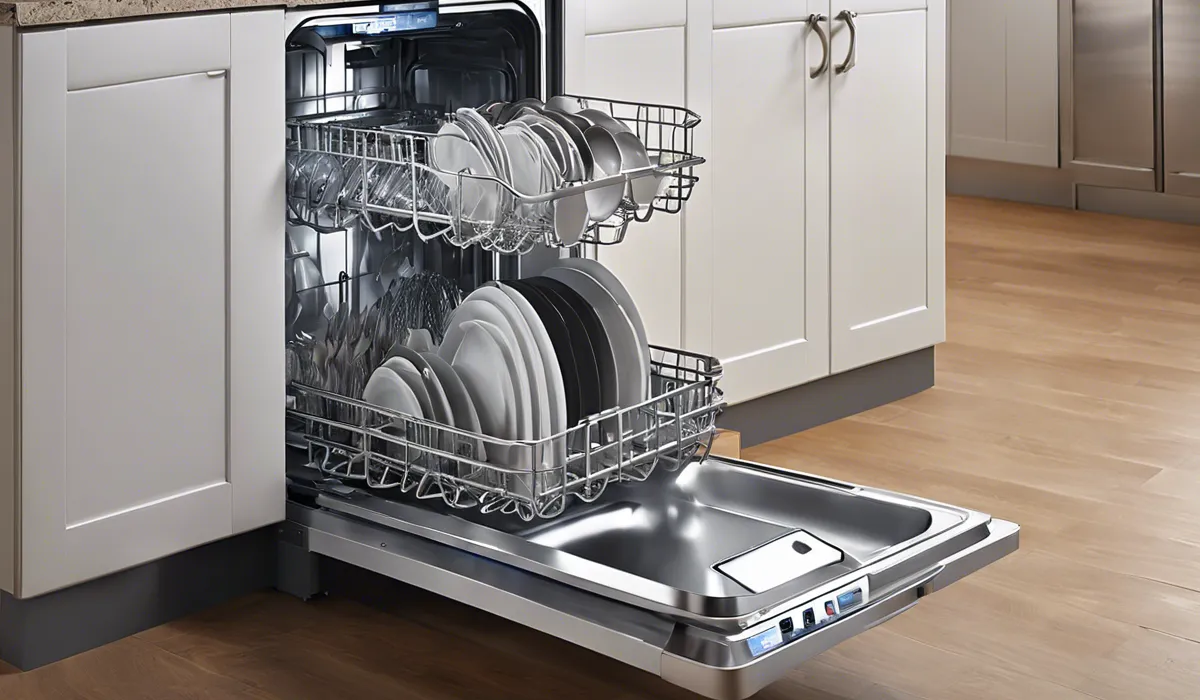How to Convert Portable Dishwasher to Built In: Easy Steps!
To convert a portable dishwasher to a built-in, remove the casing, connect the water supply and drain lines to the home’s plumbing, secure it to the cabinetry, and ensure the power cord reaches an outlet or hardwire it.
Assessing the Feasibility of Conversion

Determine Compatibility of the Portable Dishwasher
Before committing to converting your portable dishwasher into a built-in model, you must assess whether it’s compatible with the existing infrastructure. Start by inspecting the size and model of your portable dishwasher.
Verify if its dimensions align with standard cabinetry openings, which typically measure 24 inches wide.
Additionally, consider the depth and height to ensure a seamless fit. Consult the manufacturer’s specifications to ascertain the unit’s suitability for built-in installation.
Evaluate Kitchen Layout and Space Requirements
Evaluating your kitchen layout is crucial for a successful conversion. Identify the ideal location for your dishwasher, keeping in mind the need for ease of access and minimal disruption to the kitchen’s workflow.
The space must accommodate the dishwasher’s door when open, allowing for unobstructed loading and unloading. If cabinetry adjustments are necessary, consider the costs and effort required to alter the existing kitchen structure.
Check for Existing Plumbing and Electrical Connections
An integral part of the feasibility assessment includes checking for existing plumbing and electrical connections.
Your chosen location should be near water supply lines, a drain, and an electrical source, whether it’s a dedicated circuit or an outlet.
If these connections are not readily available, you will need to factor in the complexity and cost of creating new ones.
Understand the Implications on Warranty and Service
Lastly, review the warranty and service implications of converting your portable dishwasher. Alterations may void any existing warranty, and future servicing could be complicated by the unit’s built-in status.
Reach out to the manufacturer or consult the warranty documentation to clarify these aspects before proceeding.
Preparing for the Installation

Tools and Materials Needed for the Conversion
Gather the necessary tools and materials before starting the conversion process. You will need an adjustable wrench, screwdrivers, a drill, a level, Teflon tape, and possibly a hole saw for ceiling box modifications.
For materials, ensure you have supply lines, a drain hose, wire nuts, and mounting brackets. Having everything on hand will streamline the installation.
Disconnecting and Moving the Portable Dishwasher
Before moving the dishwasher, ensure it’s empty and disconnected from power and water sources. Carefully detach the hoses and drain the water to prevent spills.
Once disconnected, gently move the dishwasher to its new location, being mindful of the flooring and surrounding cabinetry.
Preparing Plumbing Connections
Prepare for the plumbing connections by identifying the hot water supply and drain under the sink. Install a dual outlet valve on the hot water supply to connect both the sink and dishwasher.
Ensure that the drain hose reaches the sink drain or garbage disposal and secure it with hose clamps. Apply Teflon tape to all threaded connections to prevent leaks.
Setting Up Electrical Connections
For the electrical setup, determine whether you will hardwire the dishwasher or use an outlet. If an outlet is available and within reach, ensure that it’s properly grounded.
For hardwiring, turn off the power at the circuit breaker, prepare the wires, and connect them according to the manufacturer’s instructions. Always prioritize safety and consult a professional electrician if in doubt.
Installing the Dishwasher as a Built-In

Securing the Dishwasher in Place
With the dishwasher in position, use a level to ensure it’s even and make any necessary adjustments. Secure the unit to the cabinetry or the countertop using mounting brackets.
This prevents the dishwasher from tipping forward when the racks are extended. Confirm that the door opens smoothly and that there is no obstruction.
Connecting to Water Supply and Drain
Connect the dishwasher’s water supply line to the dual outlet valve under the sink, tightening it with an adjustable wrench.
Attach the drain hose to the sink drain or garbage disposal, ensuring it has a high loop to prevent backflow. Test for leaks by turning on the water supply and checking all connections.
Finalizing Electrical Connections
Complete the electrical connections by securing the wiring with wire nuts and electrical tape. If you’re using an outlet, plug in the dishwasher and confirm the power cord is not a tripping hazard.
For hardwired connections, restore power at the circuit breaker and check that the dishwasher turns on without issues.
Testing the Dishwasher to Ensure Proper Function
Before considering the installation complete, run a test cycle on the dishwasher. Monitor the unit for any unusual noises, water leaks, or electrical issues.
Check the water temperature and drainage at the end of the cycle to confirm everything is functioning as expected. If any problems arise, revisit the connections and make necessary adjustments.
FAQs About Converting Portable Dishwasher to Built-In
Can you convert any portable dishwasher to a built-in?
Not all portable dishwashers are designed to be converted to built-ins; it’s important to check the manufacturer’s specifications and recommendations first.
Do I need special tools to convert a portable dishwasher?
Basic tools such as a screwdriver, wrench, and possibly a drill will be needed to remove the casing, connect the water and drain lines, and secure the dishwasher.
How do you secure a converted dishwasher to cabinetry?
To secure a converted dishwasher, use mounting brackets to attach it to the underside of the countertop or sides of the cabinets.
Is it necessary to hardwire the converted dishwasher?
It’s not always necessary to hardwire the dishwasher; if an electrical outlet is accessible, you can use the existing power cord. Check local code requirements for permanent appliances.
What should I do with the water supply and drain lines during conversion?
Connect the water supply and drain lines from the dishwasher directly to the home’s plumbing following local codes and ensure they are properly sealed to prevent leaks.
Final Thoughts
Converting a portable dishwasher to a built-in involves removing its casing, and establishing connections to the water supply and drain lines of the house.
It’s crucial to fasten the unit to the cabinetry for stability and ensure the power source is accessible, either via an outlet or through hardwiring.





